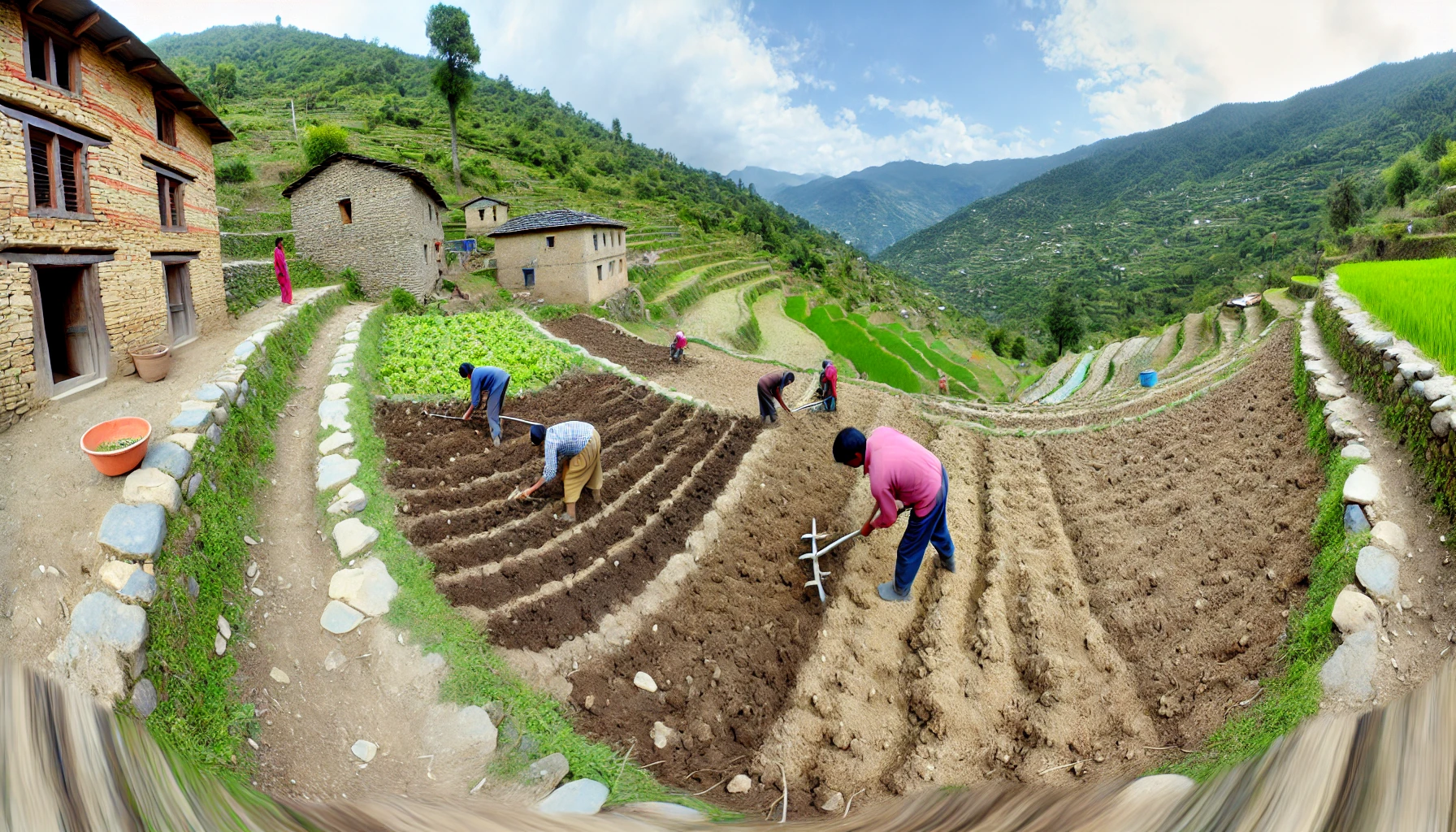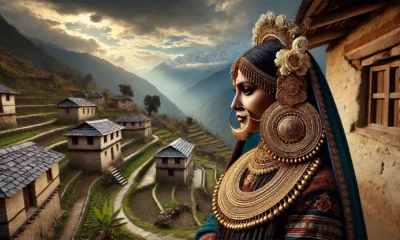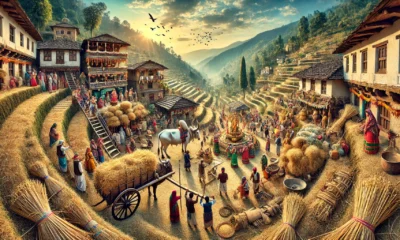
Nurturing the Land: Soil Characteristics and Agricultural Strategies in Uttarakhand”
Introduction
Uttarakhand, a state nestled in the northern part of India, is characterized by its diverse geographical and climatic conditions, which significantly influence its soil types and agricultural practices. The state, predominantly mountainous, is known for its varied soil profiles that support a range of agricultural activities. This article explores the different types of soil found in Uttarakhand and examines the state’s agricultural landscape.
Soil Types in Uttarakhand
The soil in Uttarakhand results from the weathering and decomposition of minerals, rocks, and organic matter. It varies in composition across different regions of the state. Based on the Indian Council of Agricultural Research’s classification, Uttarakhand’s soil falls primarily into the category of mountainous or forest soil. This type of soil is generally underdeveloped, with deficiencies in lime and phosphorus but a richness in organic matter. Below are the primary soil types found in Uttarakhand:
- Lowland Soil
- Found in the southern regions, such as from Dehradun to Udham Singh Nagar, this soil is formed from the deposition of fine particles. It is mature, flat, swampy, and moist, characterized by deficiencies in nitrogen and phosphorus. It is highly fertile, supporting crops like sugarcane and rice.
- Pasture Soil
- Present in lower areas near rivers, pasture soil includes various categories:
- Matiyar Loam: Brown, high in nitrogen and organic matter, low in lime.
- Highly Calcareous Loam
- Low Calcareous Loam
- Non-Calcareous Loam
- Sandy Loam
- Present in lower areas near rivers, pasture soil includes various categories:
- Tertiary Soil
- Located in the Shivalik hills and Dun valleys, this soil is light, sandy, and porous, leading to low moisture retention. It has limited vegetation and organic matter, though the Dun Valley has better moisture retention compared to other areas.
- Quartz Soil
- Found in Bhimtal, this soil is formed from the disintegration of rocks like schist and shale. It is light and infertile.
- Volcanic Soil
- Also present in Bhimtal, volcanic soil results from the disintegration of igneous rocks and is light and sandy, suitable for agriculture.
- Loamy Soil
- This soil, found on the lower slopes of Shivalik hills and in the Dun Valley, is characterized by its light consistency and high content of lime, iron, and organic matter.
- Brown Reddish-Yellow Soil
- Seen near Nainital, Mussoorie, and Chakrata, this soil is derived from limestone, sandstone, shale, and dolomite rocks. It is highly moisture-retentive and fertile.
- Red Clay
- Found on mountain slopes or hill edges, this soil is rich in organic content but deficient in lime and phosphorus.
- Burnt Clay
- Located in less sloped, subtropical to temperate regions, this soil type is found on mountain ranges.
- Top Mountain Soil
- Found in high-altitude areas with low rainfall, this soil is undeveloped due to extreme dryness and minimal vegetation.
- Upland Soil
- Located in grasslands above 4000 meters, this soil is slightly alkaline, rich in organic matter, and exhibits moisture deficiency due to wind and glacial erosion.
- Sub-Mountain Soil
- Found below grasslands in forested areas, this soil is sandy and structured at the top but unstructured below. It is reddish-brown to yellow and retains more moisture due to high rainfall.
Agriculture in Uttarakhand
Agriculture is a crucial sector in Uttarakhand, with approximately 70% of the working population engaged in agricultural activities. Despite its hilly terrain, the state manages to support a significant agricultural base.
- Land Use: Out of Uttarakhand’s total area of 53,483 square kilometers, only 12.90% (6.90 lakh hectares) is used for agriculture. The majority of agricultural land is found in the Udham Singh Nagar and Haridwar districts.
- Agricultural Holdings: According to the 2015-16 agricultural census, Uttarakhand has 881,305 holdings. The main crops include wheat (31%), rice (25%), mandua (10%), and sugarcane (8%). Agricultural land measurement is based on “Mutthi/Nali” units, with 1 Nali equaling 200 square meters.
- Types of Farming: The state practices several types of farming methods, tailored to its diverse terrain:
- Contour Farming (Samoch Farming): Involves farming along contour lines to prevent soil erosion and retain moisture.
- Terraced Farming (Seedhidar Farming): Converts steep slopes into step-like terraces for cultivation.
- Shifting Farming (Transition Farming): Used by indigenous tribes, this method involves clearing land, farming for a few years, and then moving to a new location.
- Land Classification by Fertility:
- Katil, Ukhedi, Izzar/Ejran Land
- Uparau Land: Includes Uparau Awwal (best quality) and Uparau Doyam (second best).
- Talau Land: Features Serat (excellent black soil), Phanchur (rain-dependent), and Simar (water-retentive).
- Tarai-Bhawar Land: Highly fertile, ideal for agriculture.
- Types of Hill Farming Land:
- Talau: Fertile valleys with moderate productivity.
- Uparau: Red soil, varying in quality.
- Ejran: Rocky, uncultivated land.
In conclusion, Uttarakhand’s unique soil types and agricultural practices reflect the state’s diverse climatic and geographical conditions. The combination of fertile plains, varied mountain soils, and innovative farming techniques supports the state’s agricultural economy and its reliance on farming as a primary livelihood.
Culture
The Cultural Significance of Uttarakhand’s Traditional Jewelry: Spotlight on the Nathuli

Clothing is more than just fabric; it’s a window into a region’s social, cultural, and economic fabric. Each society’s attire, including that of Uttarakhand, serves as a reflection of its traditions, beliefs, and lifestyle. In Uttarakhand, traditional attire not only showcases ancient customs and practices but also offers insights into the region’s climate, geography, social structure, and even educational systems. Our clothing is often the first clue to our identity, providing immediate clues about who we are and where we come from.
Among Uttarakhand’s traditional ornaments, the Nathuli, or nose ring, stands out as a symbol of marital bliss and cultural heritage. Worn predominantly by married women, the Nathuli is more than just a piece of jewelry; it’s a statement of cultural pride and tradition.
The Charm of the Nathuli
The traditional Nathuli, crafted from three to four tolas of gold, is a striking accessory. This circular ornament, about 10 cm in diameter, features a peacock design on the inside and is embellished with red and green stars at the bottom. Weighing between 3 to 5 tolas, the Nathuli is often supported by a chain with a silver clip to alleviate the weight on the nose. The Nathuli of Tehri Garhwal is particularly renowned for its intricate craftsmanship, including detailed stonework and kundan designs, reflecting the region’s rich artisanal traditions.
A Symbol of Prosperity
Historically, the size and weight of the Nathuli were seen as indicators of a family’s prosperity. In the past, the queens of the Tehri rulers adorned themselves with elaborate gold nose rings, and the wealthier families would have larger, heavier Nathulis. Today, while the practicalities of daily life mean that such heavy jewelry is less common, the Nathuli remains a vital piece of bridal jewelry and is worn with pride on special occasions.
Modern Adaptations
Traditionally, the Nathuli is a gift from the bride’s maternal uncle and is worn during weddings, social gatherings, pujas, and other significant events. Although the traditional gold and silver Nathulis are still cherished, modern variations now include artificial designs that cater to contemporary tastes and budgets.
In essence, the Nathuli is more than just an ornament; it’s a celebration of Uttarakhand’s cultural heritage and an enduring symbol of its rich traditions. Whether worn during a wedding or a festive occasion, it continues to be a significant marker of identity and cultural pride.
Culture
Chitai Golu Devta: The Deity of Justice and Faith in Uttarakhand

Despite worshipping Lord Shiva and Shakti, there is a rich tradition of folk deity worship among the people of Kumaon. Many ancient heroes are worshipped as folk deities, expressing the popular beliefs of the people. Each folk deity has a distinctive story, and is remembered through shikharas, temples, or jagars (ritual folk poems). Kumaon is believed to have once had a tradition of Yaksha worship, and the worship of ‘Naga’ or snakes symbolizes the reverence given to the brave.
Apart from worshipping the usual deities associated with Hinduism, the people of Kumaon also worship Kul Devta (family deity), Gram Devta (village deity), Nag Devta (snake deity), Bhumi Devta (land deity) and Veer Nayak (brave).
One of which is Golu Devta. Golu, Goljyu or Gwel Devta is very famous in Kumaon, and Golu Devta is considered to be an incarnation of Gaur Bhairav (Shiva). He is called the God of Justice and the King of Kumaon by his devotees with immense faith. Historically, he is believed to be the brave son of King Jhal Rai and his wife Kalinka and the general of the Katyuri king.
There are Gwala temples in Champawat, Chitai and Ghorakhal, however the temple at Chitai is the most famous of them. The story of Gwala is about a local king who, while hunting, sent his servants in search of water. The servants disturbed a woman who was praying. The woman, enraged, taunted the king that he could not separate two fighting bulls and started doing so herself.
Exploring the Rich Tradition of Folk Deities in Kumaon
Kumaon, nestled in the serene hills of Uttarakhand, is a region steeped in a vibrant tapestry of religious traditions. While the worship of Lord Shiva and Shakti holds a central place in the lives of many Kumaonis, the region also boasts a rich tradition of folk deity worship. This fascinating aspect of Kumaoni culture reveals a deep-seated reverence for ancient heroes and local legends, expressed through various rituals and worship practices.
The Folk Deity Landscape
In Kumaon, the worship of folk deities adds a unique layer to the region’s spiritual life. These deities, often rooted in local folklore and historical figures, are celebrated through a diverse array of rituals, including shikharas (pinnacle-shaped shrines), temples, and jagars (ritual folk poems). Each deity has a distinctive story, reflecting the popular beliefs and values of the people.
Historically, Kumaon is believed to have had a tradition of Yaksha worship, and reverence for ‘Naga’ or snake deities symbolizes respect for bravery and valor. This ancient practice underscores the region’s rich spiritual heritage and its connection to the natural world.
Diverse Deity Worship
Beyond the mainstream Hindu pantheon, Kumaoni people venerate a variety of deities that play significant roles in their daily lives and community. These include:
- Kul Devta: The family deity, guardian of the household.
- Gram Devta: The village deity, protector of the community.
- Nag Devta: The snake deity, symbolizing protection and courage.
- Bhumi Devta: The land deity, revered for the fertility and well-being of the land.
- Veer Nayak: The brave hero, celebrated for valor and heroism.
Spotlight on Golu Devta
Among these folk deities, Golu Devta stands out as a particularly revered figure. Also known as Golu, Goljyu, or Gwel Devta, he is immensely popular in Kumaon. Golu Devta is believed to be an incarnation of Gaur Bhairav (a form of Shiva) and is celebrated as the God of Justice and the King of Kumaon.
According to local lore, Golu Devta was the brave son of King Jhal Rai and Queen Kalinka. He also served as a general under the Katyuri king, embodying both leadership and valor. The tales of his courage and fairness have earned him a special place in the hearts of the Kumaoni people.
Temples and Legends
Golu Devta is honored in several temples across Kumaon, with notable shrines in Champawat, Chitai, and Ghorakhal. Among these, the temple at Chitai is the most renowned. The legend associated with this temple is both captivating and instructive.
The story goes that a local king, during a hunting expedition, sent his servants to fetch water. The servants accidentally disturbed a woman engaged in prayer. In her frustration, she challenged the king’s ability to separate two fighting bulls, and proceeded to do so herself, showcasing her divine powers.
This tale not only highlights the local beliefs surrounding Golu Devta but also reflects the deep connection between folklore and the spiritual landscape of Kumaon. The worship of Golu Devta, and other folk deities, remains a testament to the region’s rich cultural heritage and the enduring power of local traditions.
Culture
Exploring the Agricultural Practices of Uttarakhand: From Terraces to Traditional Crops

Uttarakhand, known for its picturesque landscapes and diverse topography, also boasts a rich and varied agricultural heritage. The state’s agricultural practices range from traditional subsistence farming in the hills to more commercial ventures in the plains. Here’s a closer look at the unique farming methods and key crops that define the agricultural landscape of this vibrant region.
Commercial vs. Subsistence Farming
In Uttarakhand, agriculture takes on different forms depending on the geography. The plains are primarily dedicated to commercial agriculture, while the hilly areas are dominated by subsistence farming. The major crops across the state include rice, wheat, sugarcane, maize, soybean, pulses, oilseeds, and a variety of fruits and vegetables.
The Sari System of Agriculture
One of the most distinctive agricultural practices in the Uttarakhand Himalaya is the Sari system. This traditional method involves growing crops on terraced fields, which are built into the slopes of the hills. This system is crucial for managing the region’s challenging terrain and helps in growing a range of crops such as:
- Food Grains: Wheat, paddy, maize, manduwa, and sanwa.
- Pulses: Urad, gram, pea, masoor, and rajma.
- Oilseeds: Mustard, soybean, and groundnut.
Rice and wheat are the dominant crops, covering 30.8% and 23.9% of the total cropped area, respectively. Other significant crops include Manduwa (10.9%), sugarcane (9.1%), Sawan (5.4%), and maize (2.7%).
Terrace Farming: A Sustainable Solution
Terrace farming is particularly well-suited to the steep slopes of Uttarakhand. This method creates flat areas on the hillside, reducing soil erosion and surface runoff. It’s also used to grow tea in the eastern hills, where the climate is ideal for this crop.
Key benefits of terrace farming include:
- Erosion Control: By creating steps or terraces, soil erosion is minimized.
- Improved Water Retention: Water is better retained and nutrients are preserved.
Other Soil Conservation Methods
Apart from terrace farming, several other soil conservation techniques are practiced in Uttarakhand:
- Contour Barriers: Barriers made of stones, grass, and soil along the land’s contours help prevent soil erosion.
- Intercropping: Growing different crops in alternate rows and at varying times protects the soil from erosion and improves nutrient utilization.
- Contour Ploughing: Ploughing parallel to the contours of the hill helps to slow down water flow and reduce soil loss.
- Rock Dams: Piling rocks to slow water flow and capture sediment is another effective conservation method.
Diverse Crops and Cuisine
Uttarakhand’s diverse climate supports a wide variety of crops and fruits. In the hilly areas, you’ll find:
- Fruits: Apples, pears, peaches, plums, apricots, almonds, chestnuts, kiwis, persimmons, and walnuts.
- Vegetables: Potatoes, cauliflower, cabbage, broccoli, tomatoes, onions, carrots, brinjals, French beans, peas, and okra.
In the Tarai and valley regions, the climate supports fruits like mangoes, litchis, malta oranges, lemons, aonla, guavas, and pomegranates. The state is also known for its off-season vegetables, which are highly valued in the market.
Popular dishes from Uttarakhand cuisine include:
- Rabri: Made with Jhongora (a type of rice) and buttermilk, often enhanced with radish leaves.
- Khadi: A dish made from curd or buttermilk.
- Arsa: A sweet treat made with rice and jaggery.
Spices and More
The state also grows a variety of spices, including ginger, garlic, coriander, cumin, turmeric, and chili, adding flavor and depth to its rich culinary traditions.
Uttarakhand’s agricultural practices reflect a blend of traditional methods and modern techniques, showcasing a commitment to both sustainability and productivity. Whether it’s the terraced fields of the hills or the commercial farms of the plains, the region’s agriculture plays a vital role in its cultural and economic life.
-

 Culture1 year ago
Culture1 year agoThe Cultural Significance of Uttarakhand’s Traditional Jewelry: Spotlight on the Nathuli
-

 Food1 year ago
Food1 year agoBhatt Ke Dubke: A Traditional Kumaoni Delicacy
-

 Festivals1 year ago
Festivals1 year agoA Spring Symphony – The Significance of Basant Panchami
-

 Traditions1 year ago
Traditions1 year agoGaloband: The Traditional Kumaoni Attire
-

 Blog1 year ago
Blog1 year agoWhy did a goat become a general in the Indian Army?













